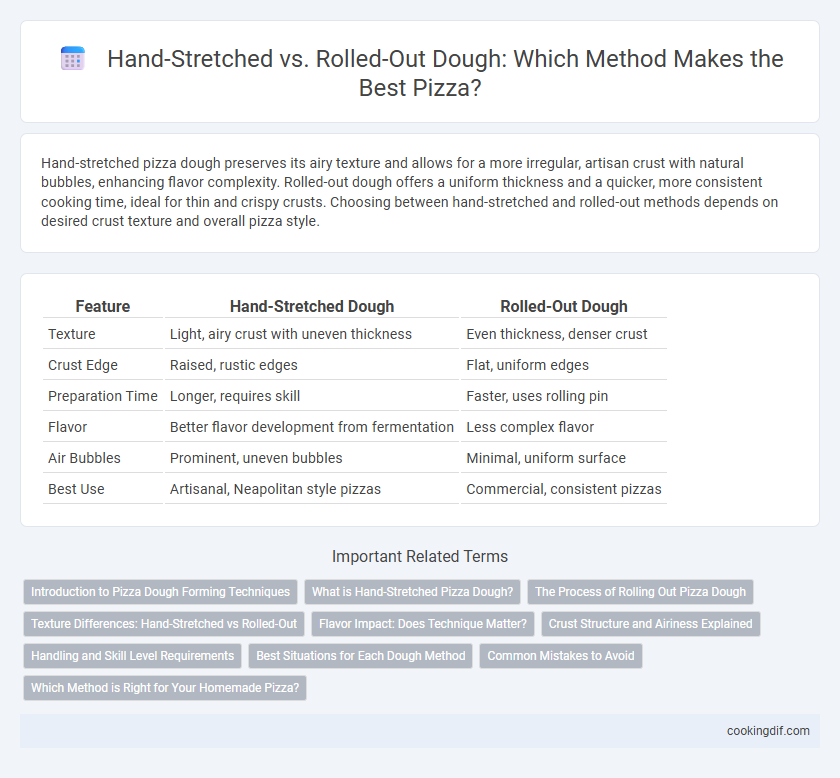Hand-stretched pizza dough preserves its airy texture and allows for a more irregular, artisan crust with natural bubbles, enhancing flavor complexity. Rolled-out dough offers a uniform thickness and a quicker, more consistent cooking time, ideal for thin and crispy crusts. Choosing between hand-stretched and rolled-out methods depends on desired crust texture and overall pizza style.
Table of Comparison
| Feature | Hand-Stretched Dough | Rolled-Out Dough |
|---|---|---|
| Texture | Light, airy crust with uneven thickness | Even thickness, denser crust |
| Crust Edge | Raised, rustic edges | Flat, uniform edges |
| Preparation Time | Longer, requires skill | Faster, uses rolling pin |
| Flavor | Better flavor development from fermentation | Less complex flavor |
| Air Bubbles | Prominent, uneven bubbles | Minimal, uniform surface |
| Best Use | Artisanal, Neapolitan style pizzas | Commercial, consistent pizzas |
Introduction to Pizza Dough Forming Techniques
Hand-stretched pizza dough maintains a light, airy texture due to its gentle manipulation, preserving gluten structure crucial for chewiness. Rolled-out dough offers uniform thickness and faster preparation, ideal for consistent baking results across multiple pizzas. Mastering these dough-forming techniques impacts crust flavor, texture, and overall pizza quality.
What is Hand-Stretched Pizza Dough?
Hand-stretched pizza dough is crafted by manually pulling and stretching the dough to create a thin, even base while preserving its natural air bubbles, resulting in a light and airy crust. This technique prevents overworking the gluten, ensuring a tender texture and authentic Neapolitan-style chewiness. Unlike rolled-out dough, hand-stretching maintains better dough integrity and a more artisanal, rustic appearance.
The Process of Rolling Out Pizza Dough
Rolling out pizza dough requires a consistent, firm pressure applied with a rolling pin to achieve an even thickness and uniform shape. This method allows for precise control over dough thickness, essential for thin-crust pizzas, ensuring a smooth surface that cooks evenly. Unlike hand-stretching, rolling out can result in a denser texture due to compressed air bubbles, affecting the final crust's lightness.
Texture Differences: Hand-Stretched vs Rolled-Out
Hand-stretched dough creates a lighter, airier crust with irregular bubbles and a chewier texture due to gentle stretching preserving gluten structure. Rolled-out dough produces a denser, uniform crust that can be thinner and crispier because the rolling compresses the dough and redistributes air pockets. Texture differences stem from the dough's handling, affecting moisture retention, gluten development, and final bite experience.
Flavor Impact: Does Technique Matter?
Hand-stretched dough preserves more air bubbles, leading to a lighter, airier crust with enhanced fermentation flavors, while rolled-out dough tends to be denser and less flavorful due to compression of the gluten network. The gentle stretching process maintains yeast activity and moisture, intensifying the overall taste profile of the pizza. Texture and flavor nuances directly impact the eating experience, making hand-stretching a preferred technique for authentic pizza crust.
Crust Structure and Airiness Explained
Hand-stretched dough produces a crust with varied thickness and irregular air pockets, resulting in a chewier texture and more complex airiness. Rolled-out dough creates a uniform thickness and denser crumb, leading to a thinner, crispier crust with fewer air bubbles. The choice between hand-stretching and rolling significantly affects the final pizza crust's structure and mouthfeel.
Handling and Skill Level Requirements
Hand-stretched dough requires greater skill and finesse, as it preserves air bubbles for a lighter, chewier crust, demanding precise control to avoid tearing. Rolled-out dough offers easier, more uniform thickness and faster preparation, ideal for beginners or high-volume production where consistent shape is crucial. Mastery of hand-stretching enhances dough texture, while rolling prioritizes efficiency and consistency in pizza making.
Best Situations for Each Dough Method
Hand-stretched dough is ideal for Neapolitan-style pizzas that require a light, airy crust with natural edge bubbles, as the gentle stretching preserves dough structure and creates an uneven, artisanal texture. Rolled-out dough suits thin-crust or pizza styles demanding uniform thickness, such as New York-style or Sicilian pizzas, ensuring consistent baking and a crispier base. Choosing between these methods depends on the desired crust texture and pizza style, with hand-stretching emphasizing tenderness and rolled-out dough favoring precision and crunch.
Common Mistakes to Avoid
Hand-stretched dough often leads to uneven thickness and tearing if not handled gently, causing inconsistent cooking and texture. Rolling out dough can compress air bubbles, resulting in a denser crust and less chewy bite, which diminishes the authentic pizza experience. Avoid over-working the dough in both methods to maintain optimal gluten development and achieve a perfect balance of crispiness and softness.
Which Method is Right for Your Homemade Pizza?
Hand-stretched dough offers a traditional approach, producing a lighter, airier crust with irregular edges and bubbles that enhance texture and flavor. Rolled-out dough delivers a uniform thickness ideal for evenly cooked, thin-crust pizzas and precise shapes, making it a preferred method for consistent results. Choosing between hand-stretched and rolled-out depends on preferred crust texture and cooking style, with hand-stretched suited for artisanal, chewy pizzas and rolled-out for thin, crispy bases.
Hand-stretched vs Rolled-out for dough forming Infographic

 cookingdif.com
cookingdif.com